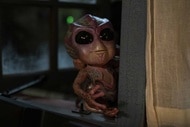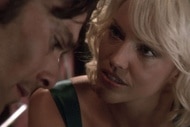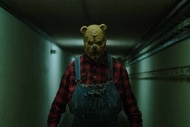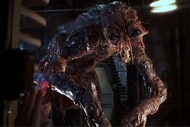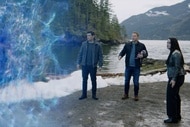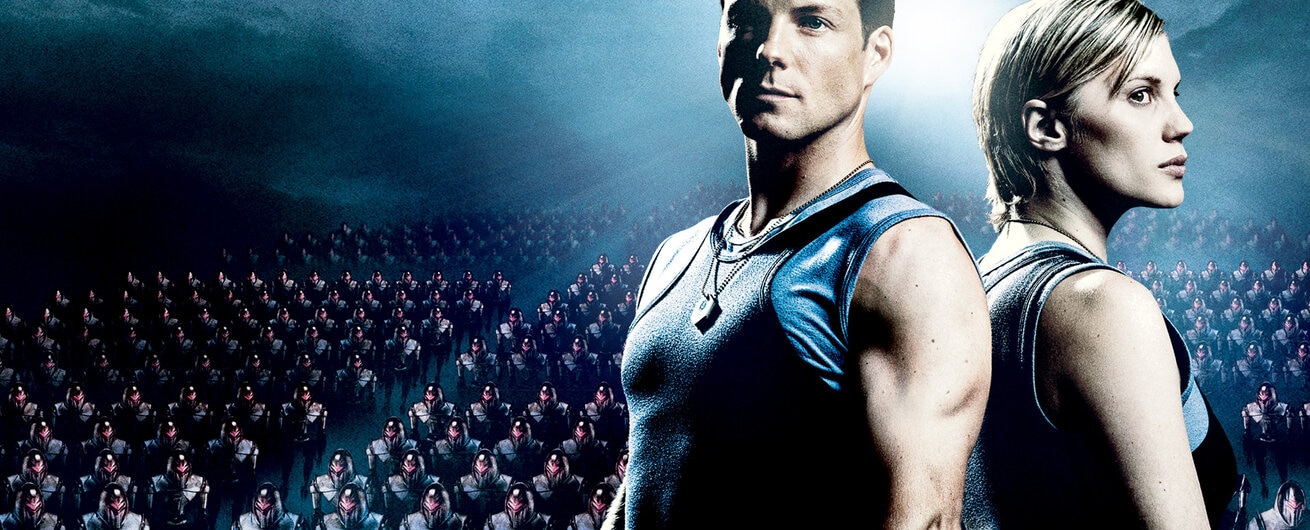Create a free profile to get unlimited access to exclusive videos, sweepstakes, and more!
13 essential Ronald D. Moore episodes you should watch, from 'Star Trek' to 'BSG'
Do you know what the great part is Odo? He's a very good tailor.
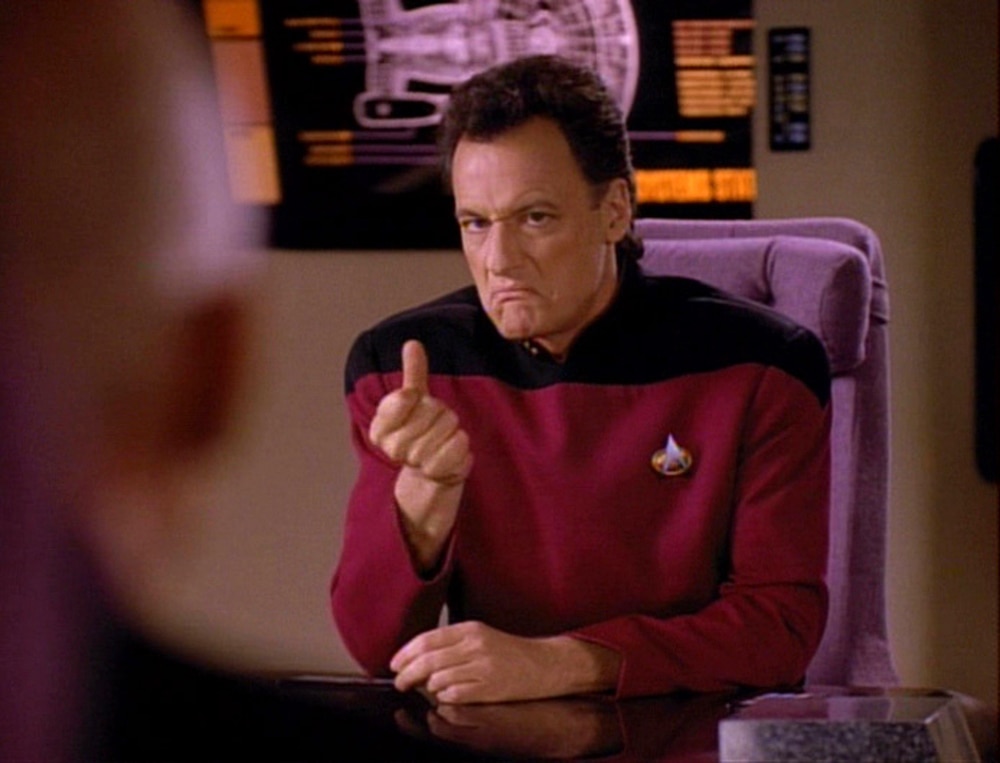
There can be no understating what effect Ronald D. Moore has had on televised science fiction. His contributions have been monumental, and they have taken place on a variety of different shows. On Star Trek: The Next Generation Star Trek: Deep Space Nine, Battlestar Galactica, Outlander, and more, he has repeatedly pushed the boundaries of what we come to expect from sci-fi on the small screen.
As part of Battlestar Galactica running once again thanks to SYFY Rewind (and the entire series streaming on Peacock) we’re going through the Ronald D. Moore catalogue of episodes that he’s lent his personal hand to. He was a creator (or co-creator) of some of these shows (BSG, Outlander), but the installments written by him (either just him or with a collaborator) tend to stick out.
Are you new to the work of Ronald D. Moore? Here are 13 essential episodes that he’s written (or co-written) that you should watch. We could easily list 100 episodes, but frak it.
1. “33” (Battlestar Galactica)
Just in case the miniseries that kicked off the rebooted BSG didn’t get you excited enough, this first real episode will. The stakes are high, the tension is thick, and the ongoing drama of the entire series is laid out in perfect fashion.
The episode is beloved by fans and critics alike, and is also a favorite among the cast and crew of the show itself. It won the Hugo Award for Best Dramatic Presentation (Short Form) in 2005. Humanity is giving everything they have to their survival, and it might not be enough. A trim reckoning, but that’s Battlestar Galactica. A perfect episode right at the start.
2. “Disaster” (Star Trek: The Next Generation)
Moore wrote this Season 5 teleplay based on a story provided by Ron Jarvis and Philip A. Scorza. It’s mostly a self-contained affair on the Enterprise D as the separated crew deal with, as the title suggests, a disaster.
Everything comes down to different character pairings and how they all manage to work together to save the ship and each other. In the wrong hands this could be boring, but Moore’s teleplay makes it unforgettable.
We expect the teams of Geordi/Crusher and Riker/Data to manage, and they do, even though Data’s head is separated for a time. It’s the placement of Counselor Troi in command (dealing with a fiery Ensign Ro) that is unexpected. Even more unexpected than that is a wounded Captain Picard stuck in a turboshaft with three kids.
He’s awful with children as this show has demonstrated, but that’s not the case at the end of this episode. That transition, perfectly written (and acted), is reason enough to watch this gem. If we ever get stuck in an elevator with Patrick Stewart, we hope he’d make us his Number One. If he wants is in charge of radishes, so be it.
3. “The Die is Cast” (Star Trek: Deep Space Nine)
Over the course of it’s third season, Deep Space Nine let everyone know that it was done being nice. It was going to play by it’s own rules, regulations be damned, and this episode is a fine example. The episode “Improbable Cause” directly sets this one up, and the result is explosive.
It’s heavy on Garak, the Cardassian tailor/super spy. For that alone, it stands out. It features Garak’s mentor, Enabran Tain. Odo gets to the heart of the investigation that happened in the episode prior, and gets much more than he bargained for. Garak himself has to torture him, and it is brutal to watch.
The Cardassian Obsidian Order and the Romulan Tal Shiar join forces to take on the Dominion. They fail spectacularly, and Benjamin Sisko has to fly in on the Defiant to salvage whatever and whoever he can. The action is insane, but it’s the character beats that make it all mean something. Every scene with Garak and Odo is incredible, as is every scene with Garak and Tain.
Garak’s final line of the episode is one of our all time Trek favorites: “Do you know what the sad part is, Odo? I’m a very good tailor.”
4. “The First Duty” (Star Trek: The Next Generation)
Written with Naran Shankar for Season 5, this episode features the return of Wesley Crusher. Miraculously, that doesn’t make it an instant skip. It’s a fascinating episode that brings Captain Picard back to Starfleet Academy, and it features some story points that would come up later on the series.
Ultimately, this episode is all about one speech. Wesley has lied as part of a cover-up, and Picard has to lay some reality on the boy that he has helped and respected for the series thus far: “The first duty of every Starfleet officer is to the truth, whether it’s scientific truth, or historical truth, or personal truth! It is the guiding principle on which Starfleet is based, and if you can’t find it within yourself to stand up and tell the truth about what happened, you don’t deserve to wear that uniform.”
It is perfectly written, and it gives Patrick Stewart (who acts the hell out of it of course) one of his finest moments in the role. This is one of the hearts of Star Trek, right here. There’s no need for the Kolvoord Starburst.
5. “Home, Part 2” (Battlestar Galactica)
Moore finally brought the remnants of humanity together after an elongated period of being at odds. Written with David Eick, this is one of the most satisfying episodes of BSG's first two seasons.
There has been nothing but escalating tension for all of Season 2, and though that never really stops, this episode does give you a breath. The fleet is united at last, and there is cohesion. A path forward is discovered, and things aren’t so hopeless. Trouble would come again, it always does, but for one moment there is union.
Nothing represents that more than the understanding that is reached between William Adama and Laura Roslin. If Mom and Dad get along, if the believer and the warrior can get along, then there is hope. Their relationship only goes forward (beautifully forward) from here.
6. “To Ransom a Man’s Soul” (Outlander)
This is hard to watch. Moore pulls no punches in this episode, co-written with DS9’s Ira Steven Behr. Jamie Fraser has been freed, so it should be a happy episode all around! Not the case, because Jamie is a broken man. He keeps flashing back to the reason why: Black Jack Randall.
We knew Randall was a bad guy, but he proves to be next-level evil. He’s out to break Jamie’s soul, and he almost succeeds. Because Jamie is reliving it on a loop in his head, we have to see it too. As we said, it’s hard to watch.
Love wins out and the healing begins, but it is a rough road getting there. None of this would work without the acting of Tobias Menzies, Sam Heughan, and Catriona Balfe. They wouldn’t have been able to do what they did without the groundwork laid out by Moore and Behr. They were adapting this from a book, sure, but it is not easy to adapt scenes like this.
To say that this episode is one giant trigger warning would be an understatement. Make sure that your own soul is secure before watching it. That isn’t a joke.
7. “Kobol’s Last Gleaming, Part 2” (Battlestar Galactica)
It’s not all about the gunshots that famously ended Season 1 of BSG on a huge “what the frak” moment, but that doesn’t hurt. There’s a lot of other things going on here.
The Helo/Sharon drama on Caprica has thankfully tied into the whole at this point. Starbuck goes at it with a Number 6, and then there’s the mutiny of the week. Lee Adama holds a gun to Saul Tigh’s head before he’s put in the brig alongside Laura Roslin. This family is not getting along.
While all of this is happening, Gaius Baltar is experiencing Kobol. He has a vision of the Opera House thanks to the Six in his head, and though we don’t know what any of this means yet, it is glorious to think about. The interplay between Baltar and Head Six is always good, but it’s particularly good here. What is the truth of the Opera House? The “dying leader” will come to know it, but not yet.
For a masterclass in writing passive aggressive lines, check out Adama’s praise for Boomer when she returns from her mission. He knows that Lee is watching.
8. “Waltz” (Star Trek: Deep Space Nine)
“And that’s why you’re not an evil man.” Season 6 of DS9 took Benjamin Sisko and trapped him in a cave with his nemesis, Gul Dukat. These two hate each other, despite the fact that they’ve been on the same side a handful of times over the course of the series. Those times are over. They hash everything out in this cave, and there’s no coming back from it.
In our opinion, Dukat is the worst of the worst when it comes to Star Trek villains. Thanks to seven seasons of DS9, he gets a lot of time to cement that status. Like Khan, and like the Borg, Dukat believes he is right. He believes that he is good. He believes that his torture, genocide, and betrayal is justified. He believes that he should be praised for it.
Sisko challenges every point he tries to make in that cave, and dismantles every argument. Dukat is not a savior, he’s just a murderous prick with an ego the size of the Celestial Temple. Dukat eventually relents and admits he hates Bajorans. They should have worshipped him, and they didn't. Like other episodes we’ve talked about, two characters in a cave could get boring fast. Not here.
Moore’s script lets two gifted actors soar. Avery Brooks hits new heights as Sisko, and Marc Alaimo? He never had a moment as Dukat that wasn't memorable. He's perfect every time he shows up. This rivalry (which is on par with Picard and the Borg, don’t at us) works because the two actors work in perfect tandem with the writing. Moore was writing for Sisko and Dukat, but he was also writing for Brooks and Alaimo.
By the time they get out of that cave, the endgame of the series has been laid out. We don’t know the specifics yet, but the situation is clear to Sisko: “From now on, it’s him or me.”
9. “Inter Arma Enim Silent Leges” (Star Trek: Deep Space Nine)
This is an overlooked gem of DS9’s final season. Julian Bashir once again has to deal with Section 31’s interference in Starfleet, only to discover (again) that Starfleet is content to let them do what they do and look the other way.
Everything that happens here flies in the face of what Starfleet is supposed to be. That's the Section 31 promise. Gene Roddenberry would be horrified, so why does this episode work? It works because Julian Bashir is just as horrified. He sees it, he calls it out, and he is utterly opposed to it.
Humanity has moved on, and every now and then you get a ship of saints. This is wartime, though, and ideals change. You do what you have to do, because lives are at risk. If you have to plan for the next war before the current war is over, then you do that. Is this an occasion where "the needs of the many outweigh the needs of the few” can be used? Possibly. One Romulan is going to be imprisoned for life, the rest of the Empire will continue to fight for the Dominion. Section 31 did their dirty work, but as Sloan tells Bashir at episode’s end, they’ll always need men like him: “Men of conscience, men of principle, men who can sleep at night.” As far as Sloan is concerned, Section 31 is the reason that Dr. Bashir is able to hold on to his high-minded ethics in the first place.
We’d usually count Admiral Ross as being a man of ethics as well. After all, he's one of the only non-evil/non-crazy Admirals in the franchise. Surprisingly, he was in on the plot. He justifies it by translating the title of the episode: “In times of war, the law falls silent.”
Admiral Ross is a good man, and this is his only morally dubious moment on the show. The galaxy isn’t only made up of saints and sinners, Sloans and Bashirs, Siskos and Dukats. Sisko himself pulls some s**t in Season 6 that would make his mother blush. Captain Kirk changed the conditions of any test whenever he felt like it. The grey areas are the most fascinating ones, and Moore brought that out here in wondrous fashion.
10. “After the Ball is Over” (Carnivàle)
Moore contributed a few episodes to the highly underrated Carnivàle, a show that got the axe way too soon. The second episode of the series sets up a lot that didn’t make sense at the time, but after the breakneck “hurry and finish what we can because we’re gonna get canned” pace of Season 2, a lot of this episode snaps into focus. There was a plan.
There are things that were great from moment one though, and they are mostly over on the Brother Justin side of the story. There’s an extended sequence where Justin reveals a certain truth to someone using magical/mystical means, and we remember quite clearly how the sequence hooked us on a show that we were already on board for.
Clancy Brown is a big part of why it works, because he’s a genius and one of the most under-appreciated actors around. We’ll say it yet again though: Moore provided the template that allowed Brown to triumph. All of the episodes that Moore wrote for this series are good, but this one is our favorite.
11. “All Good Things…” (Star Trek: The Next Generation)
Written with Brannon Braga, this is a unique series finale. It wasn’t the end for this crew, it was already known that they’d be flying onto the big screen. The series still had to end somewhere, so this spiritual closer came about. It was an afterthought, as Moore had the movie Star Trek: Generations to worry about. Time was the fire in which he burned.
Thanks to Q, the episode celebrates the past, the present, and a possible future. It gives us some of the best Picard/Q scenes that exist, especially their final one. It’s a fantastic bookend to the pilot episode, and it gives us catharsis for these characters without ending their stories.
The last scene of the episode manages to do this in an unexpected way. We’ve seen the crew of the Enterprise D play poker many times over the seasons, but we didn’t notice that Captain Picard was never present for them. He had never joined the game, and in the show’s final scene, he shows up and asks to play. He’s not playing cards with his crew, he’s playing cards with his family.
He starts to shuffle, and he looks around the table. “I should have done this a long time ago,” he says, and one of Picard’s final social walls comes tumbling down. If the feelings aren’t already pulsing, Counselor Troi’s retort may get them going: “You were always welcome.”
It’s about as perfect a finish as anyone could have hoped for, a finish that wasn’t really a finish. It was an episode that said “See you… out there” right along with Q. The sky was the limit.
12. “Daybreak, Parts 1, 2, and 3” (Battlestar Galactica)
If you prefer a finale that provides a definitive end with no sailing off to the movies afterwards, then sample of the final three-part finish of BSG. It’s a finale that is much closer to DS9, as humanity (and our characters) have reached their end. The journey is over.
Not everyone was satisfied with the answers to all of the series-long questions that were provided, but that’s not what we remember about this episodes. For what it’s worth, we were satisfied, and yes that includes certain character arcs closing out with them simply vanishing. It made sense to us then and it still does. Anyway.
The character moments are key, as always. There’s a final battle, a final reckoning, and then there are many partings. All of them are perfectly written, but there’s one moment in Part 2 that always sticks out to us. It’s a character moment that also ties in to a mystery that has been going on all series long.
Who is the Number 6 that always appears to Dr. Gaius Baltar? Where has that entity been leading him? What is the point of his journey? Aside from James Callis and Tricia Helfer being brilliant in the roles, the point is made clear by Moore when Baltar steps up to Brother Cavil and gives a speech that turns the entire three-part affair around.
“I see angels, angels in this very room. Now, I may be mad, but that doesn’t mean that I’m not right. Because there’s another force at work here. There always has been.”
When hostilities are at the their highest, when the fates of all are at their most precarious, Gaius frakkin' Baltar saves the day with this speech. They all have to live in hope, and not in fear.
If there’s one thematic takeaway from the series as a whole, we’re tempted to say that’s what it is. That is comes from Baltar is unexpectedly appropriate.
13. “Take Me Out to the Holosuite” (Star Trek: Deep Space Nine)
Yep, we really are putting this one here. Moore isn’t tough stakes/moral ambiguity/fate of humanity on the line/recovering from torture all the time. He can be fun, and this episode is a fine example.
Season 7 of DS9 gave us a few much-needed breaks from the ongoing war. Our heroes had a lot of waiting to do, and there’s only so many times that Chief O’Brien can re-calibrate the plasma manifolds or whatever. In the middle of an insanely high-stakes season, Moore wrote this episode where the stakes are “Sisko wants to beat Vulcans at baseball.”
We know Sisko loves baseball, so an episode like this was only a matter of time. He’s rarely as much fun as he is here, but that’s only the beginning. Every DS9 regular has a chance to fly free, and this includes Odo really getting into his role as an umpire and Quark actually participating. Seeing the extended DS9 family as the “Niners” baseball team is a thing of beauty.
This isn’t war, it’s just a game. It doesn’t really matter if they win, the real victory is the friends they've made along the way. That’s the lesson that Sisko learns. Rom got to score a point, so anything can happen in this game! That's why he loves it. That's something worth defending when the real bad guys come calling.
If we’re being honest, there’s one line that might make this our favorite Ronald D. Moore episode of all time. When Sisko encourages his team to start with the “chatter” and give the Vulcans some good-natured trash talk, most of the Niners give lines like “hey batter batter” and so forth.
Worf yells, “Death to the opposition!” with a straight face, almost wondering whether or not he did it right.
For more great Ronald D. Moore episodes, check out everything else that he’s worked on.


